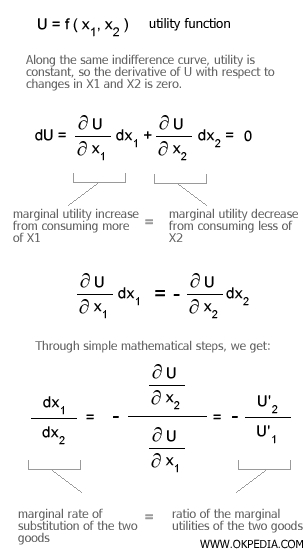Marginal Rate of Substitution
The marginal rate of substitution refers to the amount of one good a consumer is willing to give up in exchange for an additional unit of another good. This concept is also known by the abbreviation MRS. In an exchange, the marginal rate of substitution reflects how much value the consumer places on an extra unit of a good, as well as the degree to which two goods can be substituted for one another. Mathematically, the marginal rate of substitution between two goods is defined as the ratio of the change in the quantity of good 1 consumed to the change in the quantity of good 2 consumed. Given two goods, X1 and X2, the marginal rate of substitution (MRS) between them is calculated as follows:

In a Cartesian graph, the marginal rate of substitution is represented by the slope of the indifference curve, or the tangent line at any given point on the curve. The marginal rate of substitution changes at each point on the indifference curve because the quantities of the goods available to the consumer vary. For instance, at point A, the consumer has a large quantity of good X2 but a smaller amount of good X1, making them willing to give up more of the first good (3 units) to gain an additional unit of the second. The marginal rate of substitution at point A on the indifference curve is -3. At point B, to obtain one more unit of good X1, the consumer is willing to give up only two units of good X2, as they now have a larger quantity of X2 compared to point A and are therefore less willing to part with it. At point B, the marginal rate of substitution is -2, and so forth.

The tangent line at any point on the indifference curve illustrates the rate at which one good can be substituted for another. Since each point on the indifference curve represents the same utility value U, achieved through different combinations of goods X1 and X2, the differential along the indifference curve is expressed through the following derivative:

The slope of the budget constraint is determined by the ratio of the prices of the goods. This price ratio represents the market’s rate of substitution between the goods. The consumer’s optimal choice occurs when the price ratio matches the consumer’s marginal rate of substitution between the goods.

 Optimal Consumer Choice. Geometrically, this means that the consumer’s optimal choice occurs where the indifference curve and the budget constraint have the same slope, i.e., at the point of tangency between the budget constraint and the indifference curve. In the example above, at equilibrium point C, the marginal rate of substitution equals the price ratio of the goods, representing the consumer’s optimal choice.
Optimal Consumer Choice. Geometrically, this means that the consumer’s optimal choice occurs where the indifference curve and the budget constraint have the same slope, i.e., at the point of tangency between the budget constraint and the indifference curve. In the example above, at equilibrium point C, the marginal rate of substitution equals the price ratio of the goods, representing the consumer’s optimal choice.
